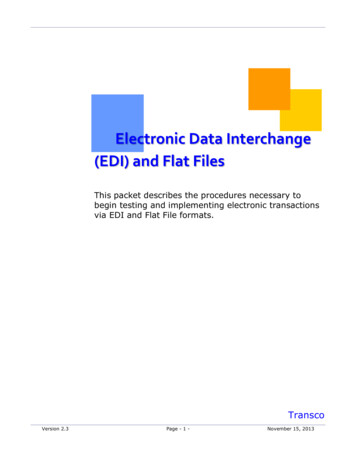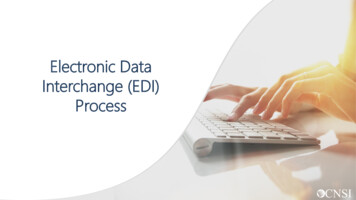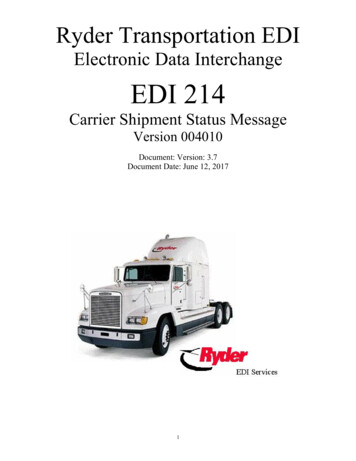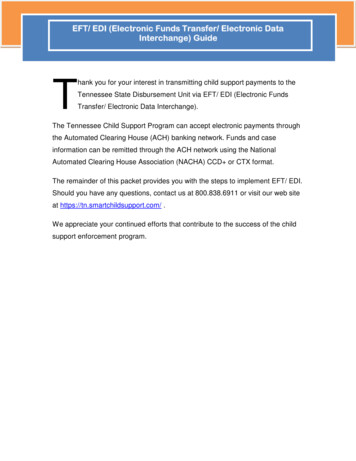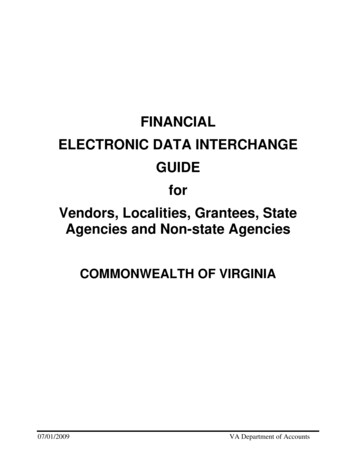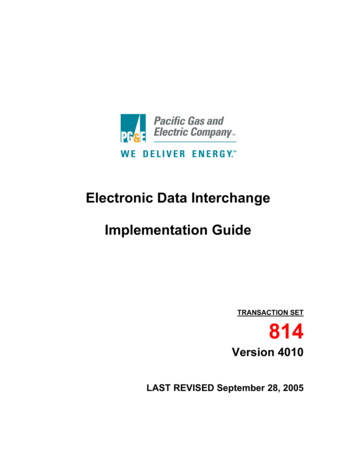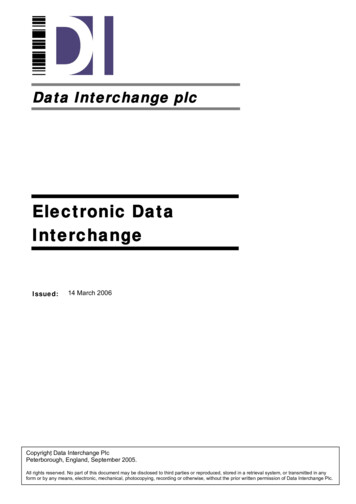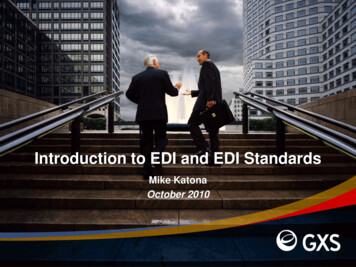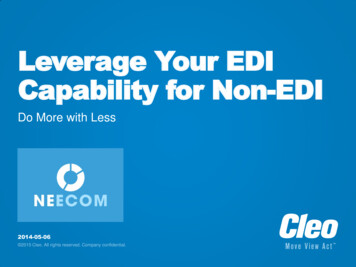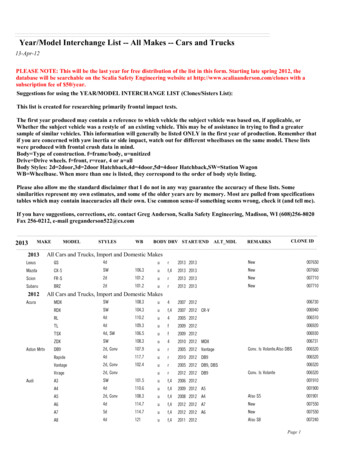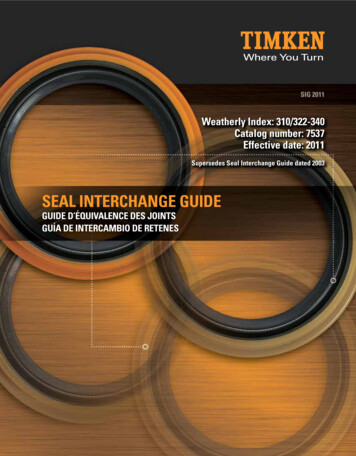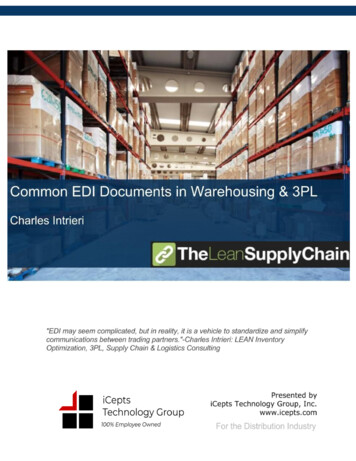
Transcription
Electronic Data Interchange (EDI):EDI is the electronic interchange of business information using a standardized format; aprocess which allows one company to send information to another companyelectronically rather than with paper. Business entities conducting businesselectronically are called trading partners.EDI lets you collaborate more efficiently with your suppliers and push costs out of thesupply chain by eliminating inefficiencies and manual interventions. Data Interchange isan industry leader in supply chain integration, for all types of and size of business.EDI solutions are used to integrate seamlessly with large and small networks ofsuppliers. Whether you are trading with a small number of SME suppliers, or a largenumber of suppliers located around the world, EDI can help with any kind of technicaland business requirement, and provide support and resources to manage.EDI may seem complicated, but in reality, it is a vehicle to standardize and simplifycommunications between trading partners. Retailers, suppliers, distributors, 3PLs, etc.all can benefit by exchanging important business documents on a secure network andin real-time. This translates into: More accurate information, less manual interventionIncreased automation and less paper.ANSI X12:The ANSI X12 series of EDI transaction sets (documents), divides the transaction setsinto market verticals for use in that specific industry or vertical. ANSI stands forAmerican National Standards Institute and the ANSI X12 series are a universal set ofstandard documents in electronic business transactions for different industries For theWarehousing/3PL industry, the 900 series of documents is the most commontransaction set, however, documents from other transaction sets such as the 856(Advance Ship Notice) are also used.To simplify the process, the following pages comprise a list of the most commonly usedWarehouse and 3PL EDI documents, in numerical order, along with their transactionname with explanations as a quick and easy reference guide:Page 2
856 Advance Ship Notice/Manifest:Data contents of the Advance Ship Notice/Manifest Transaction Set (856) for use withinthe context of an Electronic Data Interchange (EDI) environment. The transaction setcan be used to list the contents of a shipment of goods as well as additional informationrelating to the shipment, such as order information, product description, physicalcharacteristics, type of packaging, marking, carrier information, and configuration ofgoods within the transportation equipment.The transaction set enables the sender to describe the contents and configuration of ashipment in various levels of detail and provides an ordered flexibility to conveyinformation. The sender of this transaction is the organization responsible for detailingand communicating the contents of a shipment, or shipments, to one or more receiversof the transaction set. The receiver of this transaction set can be any organizationhaving an interest in the contents of a shipment or information about the contents of ashipment940 Warehouse Shipping Order:Data contents of the Warehouse Shipping Order Transaction Set (940) for usewithin the context of an Electronic Data Interchange (EDI) environment. Thistransaction set can be used to enable the depositor to advise a warehouse tomake a shipment, confirm a shipment, or modify or cancel a previouslytransmitted shipping order943 Warehouse Shipping Order:Data contents of the Warehouse Stock Transfer Shipment Advice Transaction Set (943)for use within the context of an Electronic Data Interchange (EDI) environment. Thetransaction set can be used by a depositor or an agent of the depositor to advise therecipient that a transfer shipment has been made. This transaction set provides areceiving location with detail information concerning product being shipped to thatlocation.Page 3
944 Warehouse Stock Transfer Receipt Advice:Data contents of the Warehouse Stock Transfer Receipt Advice Transaction Set (944)for use within the context of an Electronic Data Interchange (EDI) environment. Thetransaction set can be used by a receiving location to advise a depositor or an agent ofthe depositor that a transfer shipment has been received. This transaction set providesthe depositor or the depositor's agent with detail information concerning product thathas been received945 Warehouse Shipping Advice:Data contents of the Warehouse Shipping Advice Transaction Set (945) for use withinthe context of an Electronic Data Interchange (EDI) environment. The transaction setcan be used by the warehouse to advise the depositor that shipment was made. It isused to reconcile order quantities with shipment quantities.946 Delivery Information Message:The transaction set can be used by a receiving location to advise a depositor or anagent of the depositor that a transfer shipment has been received. This transaction setprovides the depositor or the depositor's agent with detail information concerningproduct that has been received.947 Warehouse Inventory Adjustment Advice:Data contents of the Warehouse Inventory Adjustment Advice Transaction Set (947) foruse within the context of an Electronic Data Interchange (EDI) environment. Thetransaction set can be used to inform a warehouse/depositor of a quantity or statuschange to inventory records. This transaction set provides detail information concerningthe internal adjustments which occur between a warehouse and a depositor.997 Functional Acknowledgement:Data contents of the Functional Acknowledgment Transaction Set (997) for use withinthe context of an Electronic Data Interchange (EDI) environment. The transaction setcan be used to define the control structures for a set of acknowledgments to indicate theresults of the syntactical analysis of the electronically encoded documents. Theencoded documents are the transaction sets, which are grouped in functional groups,used in defining transactions for business data interchange. This standard does notcover the semantic meaning of the information encoded in the transaction sets.Page 4
Electronic Data Interchange (EDI) is a critical necessity for many warehouses tocommunicate with customers, partners and retailers. EDI helps your operations runmore efficiently, keeps you current with the requirements of your customers, partnersand vendors, and most importantly, helps you to remain competitive. If you have anyquestions about this article or Supply Chain Management consulting, my contactinformation is below: - Charles “Chuck: Intrieri.Page 5
Electronic Data Interchange (EDI): EDI is the electronic interchange of business information using a standardized format; a process which allows one company to send information to another company . (944) for use within the context of an Electronic Data Interchange (EDI) environment. The t
